8 Practical Steps to Develop a Profitable SaaS Partner Program

Partner programs are one of the most effective ways to expand your sales and marketing reach. By collaborating with channel partners, you can tap into new markets, grow your customer base, and drive qualified leads to your SaaS.
But designing an effective partner program is no easy task. To create a partnership strategy that resonates with your partners and customers, you must take the right steps. So, where do you start?
Today, we'll walk you through eight essential steps for creating a partner program that will help your SaaS product thrive.
Let's start with the basics.
Table of contents
What Is a SaaS Partner Program, Exactly?
Many people need clarification on affiliate programs with partner programs. And while they have similarities, the two are different.
A partner program is a mutually beneficial relationship between your business and a partner organization. The goal is to work together to reach more customers, increase sales, and drive growth for both parties.
Partner programs come in many forms, including reseller partnerships, referral programs, and co-marketing agreements.
Sometimes, partner programs are referred to as “co-selling” initiatives because they involve actively collaborating with your partners to sell your product or service. Unlike affiliate programs, which focus on passive promotion, co-selling requires active involvement from both parties.
For example, a reseller partner program requires your partners to become experts in your product and actively promote it. In return, they earn a portion of the revenue generated from their sales.
In short, all affiliate programs are partner programs, but not all partner programs are affiliate programs.
Why Do You Need a Top-Notch SaaS Partner Program?
In today's competitive market, it's more important than ever to have a comprehensive go-to-market strategy. You need to be able to reach your target market through a variety of channels if you want to succeed.
Here’s where partnership programs come into play.
Research suggests that referral marketing drives 400% higher conversions, compared to any other marketing channel.
An even more surprising study states that roughly 9 out of 10 B2B companies have experienced growth through referral programs.
The numbers don't lie.
A SaaS partner program is the way to go if you want to scale your business and reach new markets. By attracting channel partners, you can:
- Expand your reach: When you partner with a complementary company, you gain access to their customer base. This is especially valuable if you're trying to break into a new market.
- Drive leads: A solid partner ecosystem helps you generate leads through co-marketing initiatives. For example, joint webinars, eBooks, and case studies.
- Reduce marketing costs: Partnering with another business can help you lower your customer acquisition costs. After all, you're sharing the cost of marketing initiatives with your channel partner.
- Scale SaaS company: A SaaS partner program can be a helpful growth accelerator. By leveraging your partners' resources, you can scale your business faster.
Besides, a great partner program can help you build customer loyalty and strengthen industry relationships. The more partners you have, the more credibility your business will attract.
Think about it — who would you trust more? A company that's backed by one or two partners, or a business with dozens of them?
Of course, that does't mean you should rush to sign up new partners without weighing the pros and cons. A well-thought-out SaaS partner program is essential for long-term success.
How Can You Create a SaaS Partnership Program?
Now that we've gone over the basics let's dive into the eight essential steps for creating an effective SaaS partner program.
Just keep in mind that this is not a comprehensive list. But it will give you a solid foundation to build from as you start to develop your own partnerships strategy.
1. Define Your Goals and KPIs
The first step in creating a successful partner program is to define your goals. What do you want to achieve by partnering with other businesses?
- Are you looking to reduce costs?
- Do you want to generate more leads?
- Do you want to scale faster?
Your goals will dictate the type of partners you pursue. They'll also guide your marketing initiatives and the overall structure of your program.
For example, let's say you want to reach new markets.
In that case, you'll want to partner with businesses with a customer base in the market you're trying to enter.
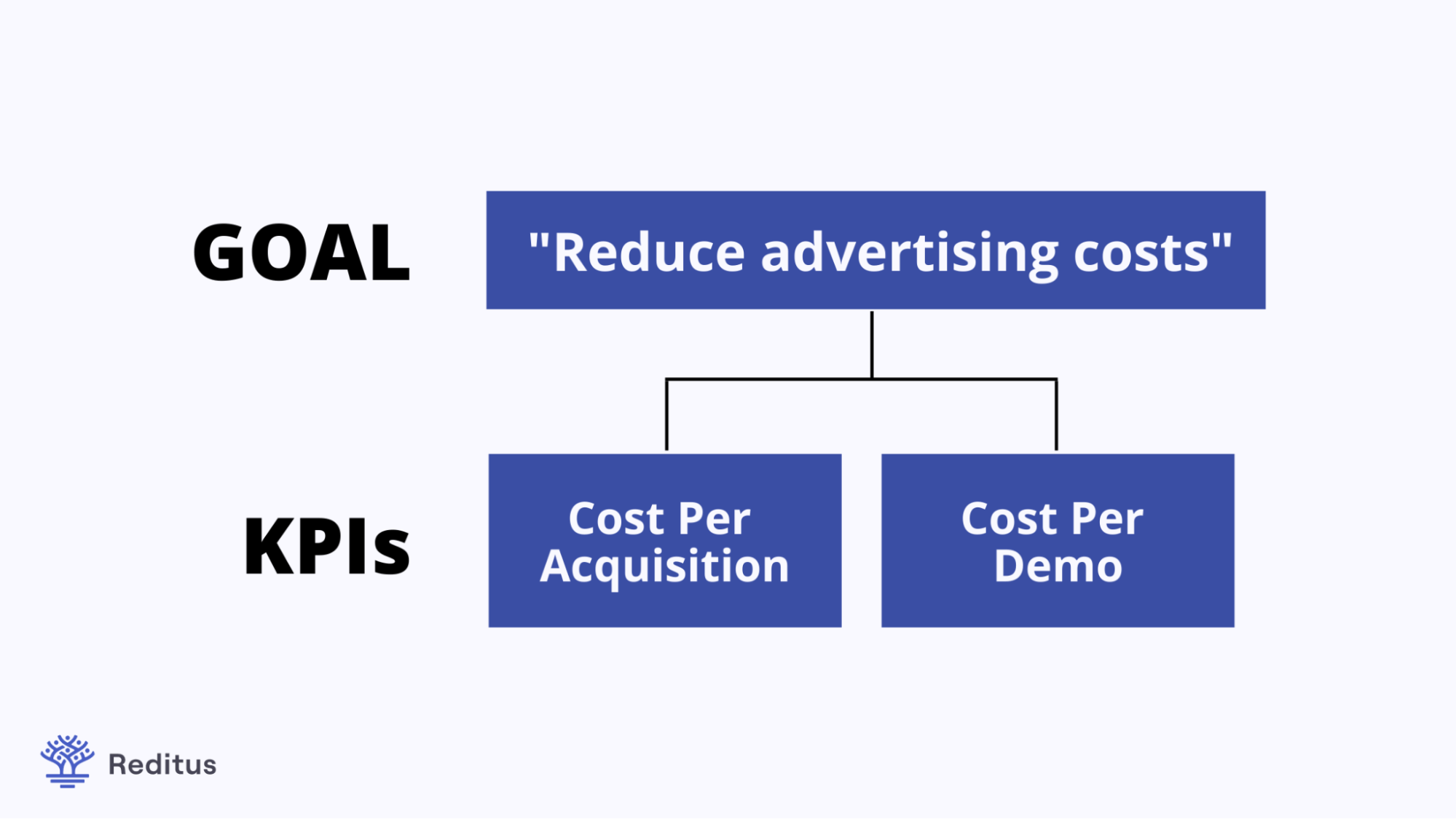
You must also set specific KPIs to measure the success of your partnership program. Otherwise, you won't be able to tell if your program is meeting your goals.
Some KPIs you may want to track include:
- Number of new leads generated
- Number of new customers acquired
- Revenue generated
- Cost per acquisition
With Reditus, for example, you can track these KPIs in one central dashboard. You can also share these KPIs with your team to help them understand how they can contribute.

By centralizing your KPIs, you can monitor your progress and make necessary adjustments to improve the performance of your program.
2. Define Your Target Partner
Once you've defined your goals, start thinking about your ideal channel partner. What type of business are you looking for?
A few questions to narrow down your search might include:
- What industry is the business in?
- What size is the company? (e.g., small, medium, enterprise)
- What is the potential partner’s target market?
- What is the business' primary sales channel? (e.g., direct, indirect, online, offline)
- What complementary products or services does the business offer?
By answering these questions, you'll get a clearer picture of your ideal partner. Some other things you should consider:
- Geographic location: Are you looking for local partners, or are you open to partnering with businesses in other areas?
- A history of successful partnerships: Has the prospect partnered with other companies in the past? If so, how successful were those partnerships?
- Brand affinity: Does the business's brand align with your own? Partner with brands that share your values and are interested in working together for the long haul.
3. Research Your Target Partners
When you know your ideal partner, it's time to start your research.
You can use a variety of methods, including:
- Online directories: Look for online directories that list businesses in your industry.
- Industry events: Attend industry events and trade shows to network with potential partners.
- Personal connections: Ask your personal and professional network if they know of any businesses that might be a good fit.
- Paid surveys: You can also use paid surveys to find potential partners. SurveyMonkey is one tool you can use for this purpose.
What should you do once you've found a few potential partners?
First, take a look at their website. Does it align with your brand? Is it professional and up-to-date? You should also review their social media accounts. How often are they active? What type of content do they share?
Next, take a look at their customer reviews. Are they positive? Do they have any negative reviews?
Finally, reach out to their customer service team. How responsive are they? Are they friendly and helpful?
You can weed out any partners that don't fit your criteria by doing your research.
4. Develop a Compelling Value Proposition
Once you've defined your target partner, it's time to add value to their business.
What can you offer that’ll make partnering with you an attractive proposition for them?
Your value proposition should be clear, concise, and compelling. You should also tailor it to your target partner. Don't simply create a generic value proposition that could apply to any business.
Some things you may want to include in your program’s value proposition are:
- Joint marketing opportunities: Can you offer joint webinars, eBooks, or case studies?
- Co-branded content: Can you create co-branded blog posts, infographics, or whitepapers?
- Exclusive discounts: Can you offer exclusive discounts on your products or services?
- Referral fees: Can you offer referral fees for customers that your partner generates?
5. Create a Partner Portal
Think about how you’ll communicate it to your referral partners.
One way to do this is to create a partner portal — a central location where your partners can access all the information they need about your program.
Your partner portal should be easy to navigate and include everything your partners need to know about your program, such as:
- An overview of your program
- Your value proposition
- A list of benefits of partnering with you
- Instructions on how to join your program
- A directory of current referral partners
With Reditus, for example, you can create a partner portal in minutes. You only need to install our pixel code on your site, and we’ll take care of the rest.
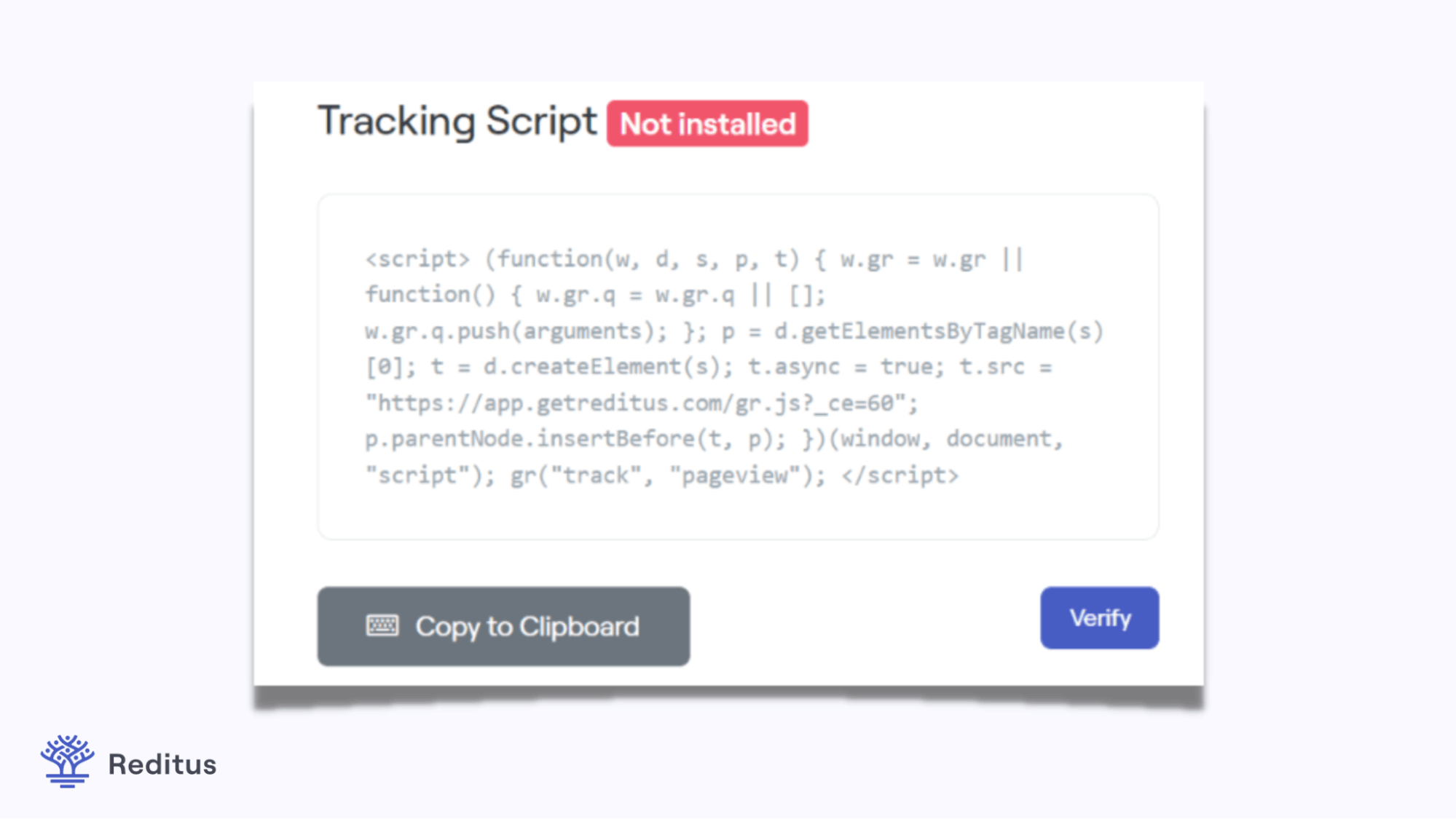
No matter your program's size, a partner portal can help you streamline your communications and make it easy for your partners to find the information they need.
Reditus helps you track and manage your partners in a single place, so you can focus on what really matters: growing your business.
6. Develop a Recruitment Strategy
A partner program without partners is a bit like a party without guests — not much fun.
That's why it's crucial to have a recruitment strategy to attract prospective partners to your program.
Your recruitment strategy should attract your target partner. If you're targeting small businesses, your recruitment strategy will differ from targeting enterprise companies.
Some things to consider when developing your recruitment strategy include:
- What methods will you use to reach out to prospective partners? (e.g., email, phone, LinkedIn)
- What kind of materials will you need? (e.g., a one-page overview of your program or a case study highlighting the success of a previous strategic partnership)
- Who will be responsible for recruiting new partners? (e.g., a dedicated partner manager, a sales team)
You can also list your program on a marketplace to make it easier for prospective partners to find you.
For example, with Reditus, you get access to our partner marketplace where businesses can browse and compare different programs.
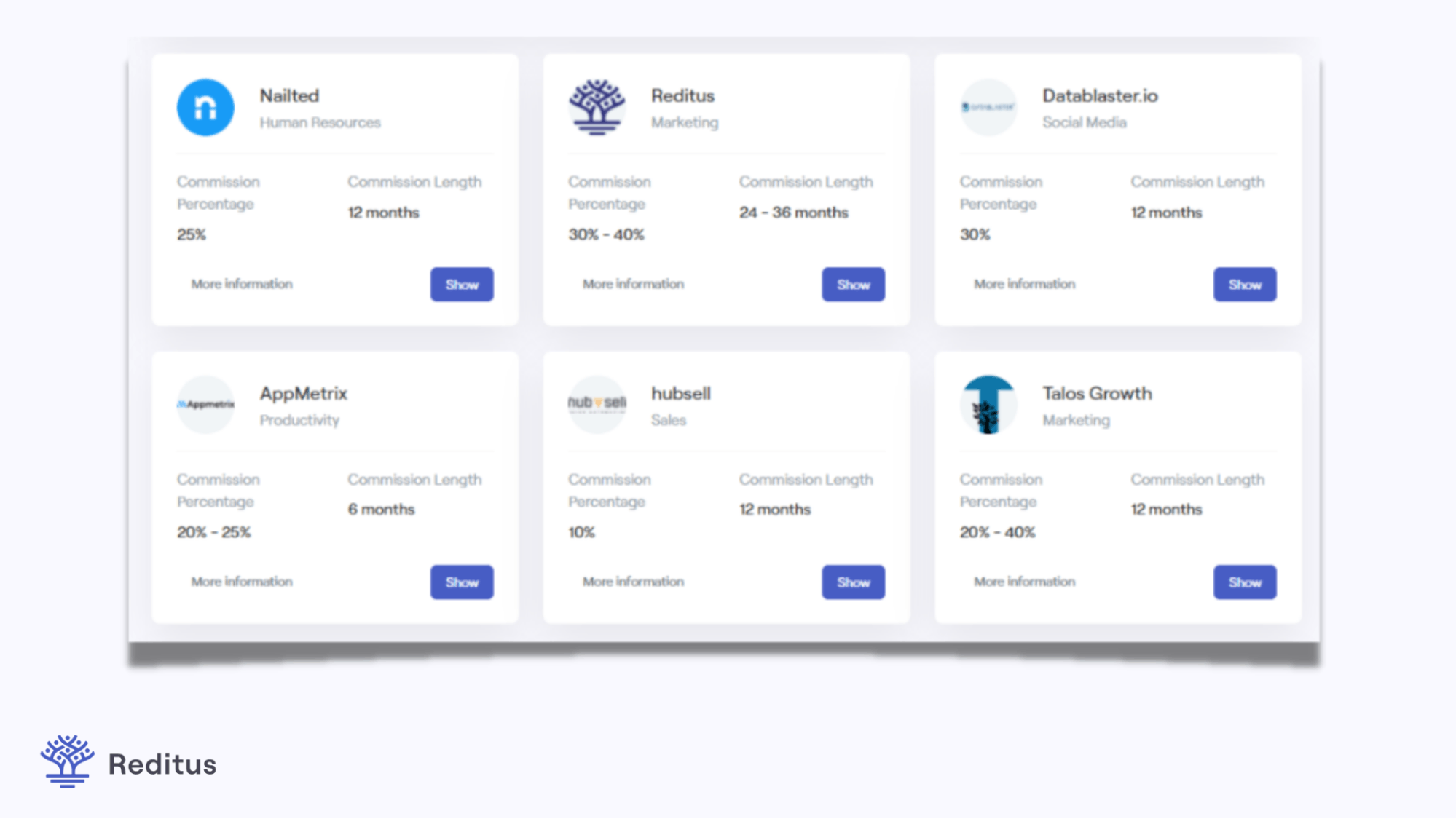
By listing your program on our marketplace, you can reach a larger audience of prospective partners and save time by only talking to businesses that are already interested in partnering with you.
7. Train Your Team
No matter how strong your channel partner program is, it won't be successful if your team isn't adequately trained to use it.
Your team should be familiar with every aspect of your program, from value proposition to recruitment. They should also know whom to contact with questions or concerns.
To ensure your team is trained correctly, you can create training materials, such as an overview of your program or a step-by-step guide on how to use it.
Hold regular training sessions to review the program with your team and answer any questions they may have.
You can also find a company that trains your team for you.
For example, Reditus offers partner training services to help you get the most out of your program.
We can provide your team with the training they need to succeed, so you can focus on more critical initiatives.This will ensure your team is appropriately trained and equipped to use your program effectively.
8. Develop a Solid Payout Structure
One of the most vital aspects of any partner program is the payout structure.
Your payout structure will determine how much your partners earn for each sale they generate.
To develop a solid payout structure, you need to consider a few things, such as:
- How much can you afford to pay your partners?
- How much do your competitors pay their partners?
- What kind of sales volume are you expecting from your referral partnerships?
Also, consider whether you want to offer a flat rate or a percentage of each sale. Depending on your business model, one option may be more advantageous.
Once you've considered these factors, you can develop a fair payout structure for both you and your partners.
The right partner program management system can help you keep track of your payouts and ensure that your partners are being paid on time.
With Reditus, for example, you can automate your payouts, so you don't have to worry about manually issuing payments each month. We offer an integration with PayPal, where you can easily connect your Paypal account and start paying your partners in bulk.
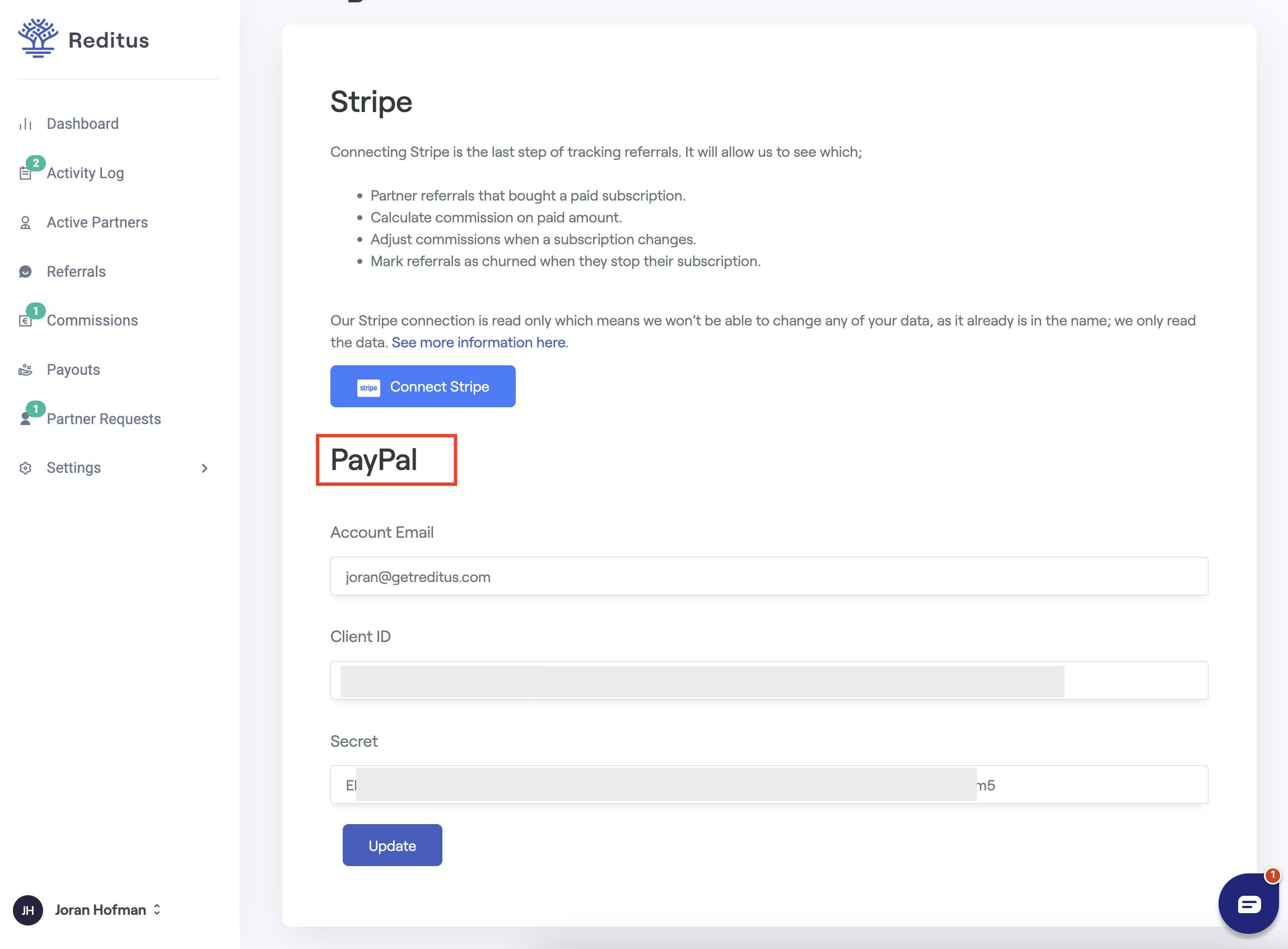
This is a great way to save time and ensure that your partners are always paid on time.
SaaS Partner Program FAQs
Before wrapping up, here are some common questions about launching a SaaS partner program.
What is the best way to recruit partners for my program?
The best way to recruit partners for your program is to target businesses relevant to your product, have a similar customer base, and need your solution.
You can use online marketplaces, industry events, or even referrals to reach out to potential partners. You should also offer incentives to attract and retain high-quality partners.
With Reditus' marketplace, you can publish your program and make it easier for prospective partners to find you.
How can I keep track of my partner program?
Using a dedicated partner program management system is the best way to keep track of your partner program. With a system like Reditus, you can track and manage your schedule in one place.
You can view analytics on your partner performance, see which partners are driving the most sales, and manage your payouts automatically.
How can I ensure my partners are successful?
To ensure your partners are successful, you must provide them with the tools and resources they need to promote your product.
This includes training materials, marketing collateral, and support from your team. You should also provide incentives and reward successful partners for keeping them engaged and motivated.
What is the best way to measure the success of my partner program?
The best way to measure the success of your partner program is to track metrics such as total sales, partner performance, and conversion rates. You can also use analytics to track how partners are driving traffic to your product page and see which sources are performing the best.
With Reditus, you can easily track all your partner program metrics in one place and get detailed insights into the performance of your program.
What should I do if my partner program isn't performing as expected?
If your partner program isn't performing as expected, you should first analyze the data and identify any weak points in your program.
You can address these issues by adjusting your payout structure, offering more incentives, or providing more marketing materials. Additionally, you should evaluate your partner recruitment process and ensure you are targeting the right partners for your program.
What Are the Next Steps?
At this point, you should have a good understanding of what it takes to develop a successful SaaS partner program.
Now, it's time to put what you've learned into action.
If you're looking for a platform to start and manage your partner program, Reditus might be the right solution.
Let's explore why.
Full guide on setting up a partner program.
What is Reditus?
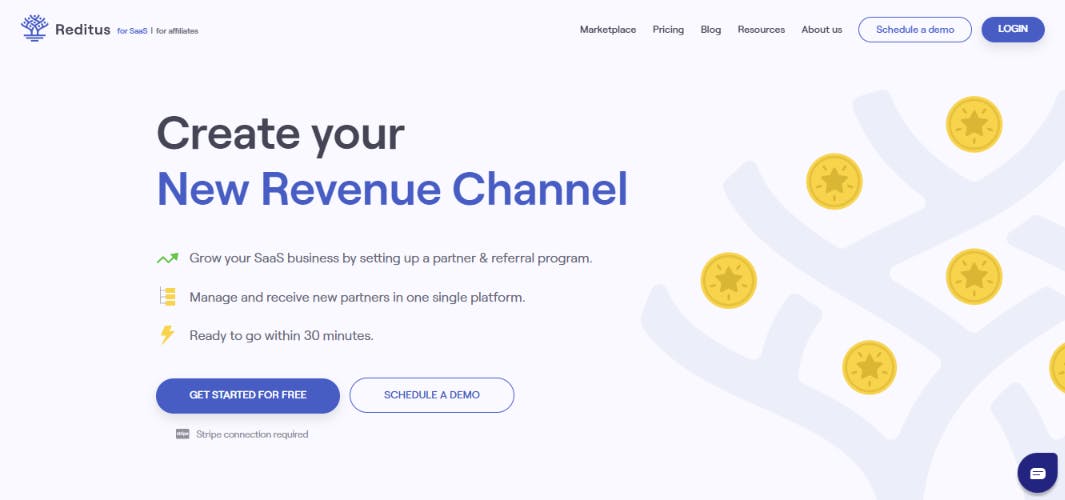
Reditus is a partner relationship management system (PRMS) that helps you develop, monitor, and manage your SaaS partner program easily.
With Reditus, you can:
- Create a custom partner or affiliate program in minutes
- Recruit partners on autopilot with our partner marketplace
- Onboard and train your partners in one central location
- Manage your payouts with our automated payout system
- Monitor your program's performance with our detailed reporting
You can also use Reditus to develop and manage other types of SaaS partner programs, such as:
- Affiliate Programs
- Referral Programs
- Influencer Programs
These features will help you develop a successful program that generates more channel sales and revenue for your business.
Start Managing Your Partner Program Efficiently With Reditus
A SaaS partner program can be a great tool to scale your SaaS company.
However, developing a successful program is not easy. It takes careful planning, execution, and ongoing management to ensure that your program is effective.
And, if you're looking for a partner relationship management system to help you develop and manage your program, Reditus is the perfect solution.
Schedule a free demo today to see how Reditus can help you start your SaaS partner program on the right foot.

